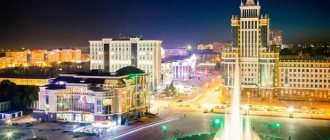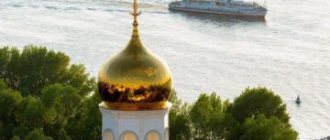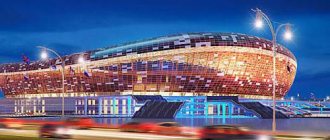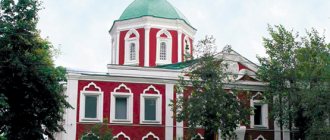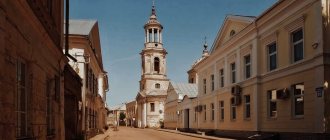Saransk
History of Saransk
Back in the 1st millennium BC.
e. On the territory of modern Mordovia lived peoples belonging to the Finno-Ugric group - Erzya and Moksha. Traditionally, they are called Mordovians, although the Erzyans and Mokshans themselves identify themselves as independent ethnic groups. They differ in appearance, have their own traditions and language. The name of the city of Saransk comes from the concept “sara”, which, translated from local Finno-Ugric dialects, literally means “swampy, swampy places”. Presumably, the name of the city is associated with the names of the rivers Insar and Saranka. In the 17th century, when a fort began to be built on the site of modern Saransk, they overflowed widely, forming vast swampy spaces. The foundation of the fortress dates back to 1641 and is associated with the name of the governor, Prince Savva Kozlovsky, who supervised the work at the behest of the Moscow Tsar Mikhail Fedorovich, the first Russian ruler from the Romanov dynasty. The Saransk “fortress” was built as one of the most important links in a large defensive line that protected the southern and southeastern lands of the Russian kingdom from the devastating raids of the Crimean and Nogai Tatars. Initially, the fortified fort was inhabited by Cossacks, archers, gunners transferred here from neighboring fortified cities, as well as residents of various nationalities from nearby settlements.
The first railway station of Saransk, built in 1893
Saransk at the beginning of the 20th century
The fortress had an almost square shape, with log towers erected at the corners. The citadel was surrounded by earthen ramparts with a high, pointed palisade dug on top. According to all the rules of fortification of that time, deep ditches stretched from the outer side of the rampart to protect against assault. Along the inner side of the rampart there were also walls with devices for defense. The prison occupied a fairly large territory for those times, the area of which can be compared with the average modern city block.
In 1651, Saransk, around which there were already settlements inhabited by servicemen and townspeople engaged in small trade and crafts, became the administrative center of Saransk district, although it was granted city status only in 1780.
Saransk in the 60s
In 1670, Saransk was captured by the troops of Ataman Mikhail Kharitonov, one of Stepan Razin’s associates. For several months, the city and the district served as a stronghold for peasants and Cossacks who rebelled against the tsarist government. Government troops managed to expel the rebels from the city only after several unsuccessful attempts to storm.
By the beginning of the 18th century, the strategic position of Saransk was reduced to a minimum, and it turned into a city of artisans and traders. The development of commerce was facilitated by the favorable location of the former fort at the intersection of trade routes connecting Astrakhan with Moscow and Kazan with the Crimean Peninsula. Until the end of the 70s, Saransk was ruled by voivodes, the city’s population exceeded 5,500 people, and there were about 700 households.
In 1774, the townspeople greeted Emelyan Pugachev with enthusiasm, believing the rumors that he was Emperor Peter III. The three-day stay of the imaginary king in the city was marked by the execution of a number of nobles, officials, and church servants, as well as the granting of freedom to the peasants and the release of prisoners. After Pugachev left Saransk, tsarist troops entered the city, putting an end to the fleeting freedom of the townspeople.
By the beginning of the 19th century, Saransk belonged to the Penza province. This century was marked by the industrial development of the city and its redevelopment. Iron and brick factories, factories for the production of soap and shag began to operate here, and small businesses developed. In 1893, Saransk joined the cities of the Volga region, through which the Moscow-Kazan Railway line was laid. Residential buildings in Saransk remained wooden. Only a few churches and a number of houses of wealthy merchants and local nobility were built of stone. Three major fires that systematically destroyed wooden buildings did not affect the preference of the majority of citizens to build their homes from wood. Wooden buildings prevailed in the city until the middle of the last century.
Soviet power came to Saransk in 1917. Until 1934, the city had the status of first a district and then a regional center. On December 20, 1934, it became the capital of the Mordovian Autonomous Soviet Socialist Republic. During the Second World War, Saransk factories produced ammunition, uniforms, and food for the army; many institutions were converted into hospitals. In the post-war years, a diversified industry developed in the city, new residential areas were developed, and by the 80s of the twentieth century, Saransk was a developed industrial center.
Since 1991, Saransk has the status of the capital of the Republic of Mordovia - a subject of the Russian Federation. Together with the whole country, it survived the controversial 90s, when, unable to withstand market competition, many city-forming enterprises closed. At the beginning of the new century, Saransk began to regain its position as a major regional center. Recently, the city's infrastructure has been significantly modernized, which was also facilitated by the hosting of the FIFA World Cup matches here in 2022. In preparation for this significant event, an international-class stadium “Mordovia Arena”, new roads and transport interchanges, hotels were built, and finally, after a large-scale and lengthy reconstruction, Saransk Airport reopened its air gates.
Mordovia Arena Stadium
Geography and climate
Saransk is located in the forest-steppe zone of the central part of the floodplain of the Insar River, which is part of the vast territory of the Volga basin. Within the city limits of Saransk, the Saranka River flows into Insar on the left bank, and the Tavla River flows from the right bank.
Saransk from satellite
The city's topography is determined by its location on the Volga Upland. A characteristic feature of the landscape is the asymmetry of the slopes on which the urban areas are located. The southern and western hills are steeper, the northern and eastern ones are almost flat. Close to the southwestern and northwestern outskirts of the city there are forests, where mainly oaks, maples, ash trees, and elms grow. The undergrowth is dominated by rowan, bird cherry, euonymus, and hazel. The banks of the Insar River and its tributaries, as well as ravines and ravines, are covered with meadow grasses.
From the nearest regional center - Penza - Saransk is separated by 128 km, from the capital of the Russian Federation - 500 km in a straight line and 642 km along the highway. Local time corresponds to Moscow.
The climate of Saransk is characterized as moderate continental. Winters here are quite cold, and summers are hot. In winter, it is usually cloudy, strong winds often blow, and snowstorms are common. The average air temperature is about –15…–10 °C. Sometimes there are frosts of 30 degrees, but there are also thaws. The coldest month is January.
Spring comes to Saransk at the end of March – beginning of April. Early spring is characterized by the return of cold weather and frosts. At the end of April – beginning of May it is already warm, the daytime temperature exceeds +20 °C. Dry winds are observed at this time.
In summer the air warms up to +25…+30 °C. The hottest month is July, which is also the rainiest, although thunderstorms, showers, and squalls are also possible in June and August. Unfavorable phenomena of the summer season also include droughts, hot winds, and abnormally high temperatures, when the thermometer records a temperature exceeding +35 °C.
Real autumn comes into its own from mid-September. If in the first weeks of the month the daytime temperature is still maintained at +20...+22 °C, then at the end of the month it drops to +10...+13 °C. By the end of October frosts begin. In the second ten days of November it becomes winter-like cold, the temperature drops below 0 °C, snow falls, and rivers begin to become covered with ice.
Mordovian State University named after N.P. Ogarev main building
City districts and population
Administratively, Saransk is divided into three districts: Leninsky, Oktyabrsky and Proletarsky. However, townspeople do not use these names in everyday life. Other names of microdistricts and residential areas have long taken root here, which are even used in the names of stops on transport routes: "), "Svetotehstroy", "Elevator", "South-West", "Khimmash" (old and new), "Nizy", “Ambassador”, “TC-2”, “Gypsy”, “Promzone”. This unofficial division of the city corresponds to its existing historical development.
About 320,000 people live in Saransk, almost two-thirds of them are Russian. Erzyans and Mokshans are the second largest group, there are about 70,000 people. There are also a lot of Tatars here – more than 16,000 people.
Walk around Saransk
There are not too many historical attractions in Saransk, but the city deserves to get to know it better. You can start a walk around the capital of Mordovia from the place where Bolshevistskaya street intersects with Sovetskaya. Here you will see one of the main city attractions - the Cathedral in honor of the righteous warrior Fyodor Ushakov. The majestic blue and white temple, built in the neo-Byzantine style, seems to float above the city, sparkling with golden domes and striking with its grandiose size.
Cathedral in honor of the righteous warrior Fyodor Ushakov
Service in the cathedral
The cathedral was erected in 2006 and consecrated by Patriarch Alexy II. The height of its dome reaches 60 m, and it can accommodate more than 3,000 people. This temple is the largest in Mordovia and one of the largest in the entire Volga region. The belfries of the temple are crowned with 12 bells, specially cast using ancient technologies in the Yaroslavl region. The main bell weighs 6 tons, the next one weighs 3 tons, then 1.5 tons, etc. If you climb to the first level of the roof, to a height of 40 m, a beautiful panorama of Saransk will open before you.
Monument to Admiral Fyodor Ushakov in Saransk
The bright, spacious interior of the temple is richly decorated and impresses with its sacred beauty. After sunset, the Cathedral is spectacularly illuminated and looks no less magnificent than during the day.
Orthodox fairs are often held on the elegant square in front of the cathedral. There is a monument to Fyodor Ushakov here - a four-meter sculpture made of bronze. The legendary admiral, who did not lose a single battle, spent the last years of his life in Mordovia, doing charity work. He was canonized in 2001. Also next to the temple there is a monument to Patriarch Nikon - the only one in Russia.
A short walk from the cathedral is the Church of St. John the Evangelist. Built in 1693, it is not only the oldest temple in Saransk, but also the oldest surviving building in Mordovia. From 1991 until the time the cathedral was erected in the name of Fyodor Ushakov, this ancient church had the status of a cathedral. The five-domed temple looks elegant and strict, reminiscent of churches in the Moscow region and Pskov.
Church of St. John the Evangelist in Saransk
Soviet Square in Saransk
Very close to the Cathedral and the Church of St. John the Evangelist there is a recreation park named after. A.S. Pushkin is a favorite place of the townspeople. Its history begins in the 19th century, when a city garden was laid out on this site. Before the revolution, amateur theater actors performed here, free cinema operated, and folk festivals took place. In 1935, the garden area was expanded five times, planting it with greenery and flowers. Over time, a summer theater, a dance floor, a cafe, and a new summer cinema appeared here. Today the park covers an area of 40 hectares. It was landscaped taking into account new trends in the art of landscape design. Here the system of reservoirs was updated, nice sculptures and fountains were installed, lawns and flower beds with original flower arrangements were laid out. The park has many attractions, including a Ferris wheel, free playgrounds, and a boat and catamaran rental station on the river bank. The zoo located here is home to many animals, including monkeys, pumas, tigers, and lions.
There are cafes in the park; stalls sell pies, sausage rolls, ice cream, cotton candy, water, and kvass. In general, you can have a great time here for the whole day, having about 1,500 rubles with you for entertainment and snacks.
Recreation Park named after. A. S. Pushkin in Saransk
Near Pushkin Park, take a look at the beautiful, cozy Church of the Assumption of the Blessed Virgin Mary, built in 1734. At the beginning of the 19th century it was rebuilt in the classicist style. In Soviet times it did not function, but in the 80s of the last century the church was restored, and in the 90s it was returned to the fold of the Orthodox Church.
The oldest temples in Saransk include the Trinity Church, built in 1701. True, since then it has been rebuilt several times. This temple is a slender, miniature white building of classical shape with dark green roofs and two small gilded domes. The church is located approximately a kilometer east of the Cathedral, on Volodarsky Street.
Assumption Church in Saransk
Trinity Church in Saransk
In the eastern part of the city, across the Insar River, in the Khimmash area, there is another historical landmark - St. Nicholas Church. Built at the end of the 19th century, it is a majestic five-domed structure. The temple is made of red brick, which gives it a special color and solemnity.
St. Nicholas Church
Pugachev tent in Saransk
In the very center of Saransk, on Moskovskaya Street, there is a memorable place associated with Emelyan Pugachev’s stay in the city. This is the so-called Pugachev tent, which is a small stone house. According to legend, from his porch heralds read out manifestos issued by the leader of the peasant uprising, who proclaimed himself tsar.
Once on Moskovskaya Street, take a look at the Mordovian Republican Museum of Local Lore. It is located in the beautiful building of the Nizhnekazan (Three Saints) Church, which is an architectural monument of the 17th century. The museum has three departments: historical, modern, and nature of Mordovia.
The entrance ticket costs 80 rubles for adults, 20 rubles for children. Guide services must be paid separately.
Monument to Pushkin in Saransk
Mordovian Republican Museum of Local Lore
Moskovskaya Street in Saransk also includes Fountain Descent. There are three cascading fountains, equidistant from each other. On the descent there is a monument to Pushkin, which is one of the calling cards of the city.
Museum of Fine Arts. Stepan Erzya
Nearby, on Kommunisticheskaya Street, is one of the most famous museums in Mordovia - the Museum of Fine Arts. Stepan Erzya. This name belongs to a wonderful Mordovian sculptor; the museum has a large collection of his works. Stepan Erzya, a master who created sculptures from wood, reinforced concrete, and marble, lived for a long time in Europe and South America, but then returned to his homeland with his creations. His expressive Art Nouveau works make a lasting impression. No less interesting are the paintings of the famous portrait painters Ivan Makarov and Fedot Sychkov. In the hall of Russian painting you can see paintings by Aivazovsky, Shishkin, Savrasov. The museum has professional lighting installed, and you get the feeling that an inner light emanates from the paintings. Visit the ground floor, where small sculptures, samples of Khokhloma, Zhostovo dishes, and crystal are collected.
This museum has several branches, the closest is the Museum of Mordovian Folk Culture, located on Sovetskaya Street. The Erzya House-Museum and the Sychkov House-Museum are located outside Saransk, in the villages of Baevo and Kochelaevo, respectively.
Entrance to the main building of the museum costs 150 rubles.
St. John the Theologian Monastery
A 5 km drive from Saransk, in the village of Makarovka, there is a place that every guest of the city must visit. This is the St. John the Theologian Monastery. The first buildings appeared here at the beginning of the 18th century. These were the cold Church of St. Nicholas the Theologian and the warm Church of St. Michael the Archangel with it, built by the landowner Makar Polyansky. However, neither the temple nor the church were parish, but served for two centuries as family sanctuaries of the Polyansky family, which owned the local lands.
John the Theologian Monastery in Makarovka
Over time, the Polyanskys built almshouses nearby, first for men, then for women, and surrounded the territory with a wall, according to monastic custom, but for a number of reasons this place did not become a monastery. At the beginning of the 19th century, the Church of the Icon of the Sign of the Mother of God was also built here. Over time, a whole park and architectural complex with temples, bell towers, a park, ponds and bridges across them was formed here. At the beginning of the twentieth century, the Makarovsky Pogost, as it was then called, came under the jurisdiction of the church parish. The peasant community could not adequately support it, and by the 1917 revolution everything here had fallen into disrepair. In the 60s, the complex began to be restored, in the hope of creating something like an open-air museum with a recreation area. The plans did not come true, and in 1987 local residents managed to demand from Patriarch Pimen the St. John the Theological Church under the jurisdiction of the parish. Over the following years, the churchyard was gradually transferred to the believers. Finally, in 1994, it turned into a real monastery: with the blessing of Patriarch Alexy II, the St. John the Theological Monastery was opened here.
Today the churches of the monastery are open to believers and pilgrims. There is a pilgrimage center, a refectory, and a hotel here. Ordinary tourists will be curious to see beautiful religious buildings with a rich history and take a walk through the huge monastery park.
Entertainment
There are 3 theaters in Saransk - Musical, Dramatic, Mordovian National; There are many cinemas, most of which are equipped with modern technology. The whole family can relax in the entertainment center. It is divided into several zones, in which numerous attractions are designed for guests of all ages, from children 2-4 years old to adults who like to have a fun and active time.
Yaushev Opera and Ballet Theater in Saransk
If you want to play billiards, go to the Mordovia sports complex or the Formula C sports and entertainment complex, which has 8 Russian billiard tables, in addition to having 2 pools and 1 nuker. The Rado entertainment complex offers bowling and also houses the Iceberg nightclub.
Saransk at night
The nightclub is also part of the Kinomax-Pobeda entertainment complex, located in the very center of Saransk, on Lenin Avenue. It is called “Horovod” and attracts with its large hall for 220 people, a spacious dance floor, a restaurant with European and Japanese cuisine, and a contact bar. Professional sound and lighting equipment is installed here, and parties are often hosted by famous DJs.
The Chateau nightclub, part of the Polar Bear entertainment complex, is popular in Saransk. Here guests will find discos, performances by fashionable DJs, and a go-go dance support group. The Chateau hosts themed parties and costume shows.
The Arbat nightclub, which opened in 2016, quickly gained fame and today is one of the popular nightlife establishments in Saransk.
Souvenirs
Monument “Airplane” in Saransk
You will not go wrong if you purchase any product with hand embroidery as a souvenir of your trip to Saransk. This type of needlework has always occupied a special place in the decorative and applied arts of the Mordovians. In traditional patterns, the predominant ornamental motifs are geometric shapes, classic colors are red, black and white, but blue, yellow, and green colors are also found. Beads are often added to the thread. In stores in Saransk you can buy hand-embroidered clothes, as well as elegant tablecloths, towels, and bed linen. Mordovian ornament is admired both in Russia and abroad. By the way, back in the 19th century, at the World Exhibition in Paris, the embroidered national costume of an Ezrian woman received a Gold Medal.
Among other original Mordovian souvenirs: carved wooden figurines - famous crafts of Tavlinsky masters, Urusov felt boots, baskets, boxes, products woven from wicker and birch bark, Mordovian dolls.
Alcoholic products from Mordovia are also in demand among tourists. The most popular brands are “Samovar” and “Chistye Rosy”. As a delicious souvenir from Saransk, you can bring wonderful natural sausages and cheeses from local factories.
Kitchen
Mordovian cuisine, on the one hand, is close to traditional European, and on the other, it is not without a Finno-Ugric flavor. You can verify this by visiting the Mordovian Compound restaurant of national cuisine in Saransk. Here guests enjoy the original, rustic interior and cozy atmosphere. The chefs cook very tasty game, grilled duck breast, dumplings with venison, soup in bread, wheat pancakes, dumplings with cottage cheese, cherries and, of course, the national Mordovian dish - “bear's paw”. In the restaurant you can taste Mordovian moonshine (chenke). There is a play area for children.
Monument “Forever with Russia” in Saransk
Another restaurant where you can taste traditional Mordovian dishes is “The Eighth Wonder of the World”. However, the menu here also offers a wide range of dishes from European and Japanese cuisine. In the same building, on the ground floor, there is a nice art cafe “Arbuzov”. They make wonderful ice cream and cocktails here. Regulars claim that they serve the best Greek salad in the city. You can also stop by the cafe for a business lunch. It will cost 200 rubles per person.
Also popular are establishments with original cuisine - the Argo restaurant and the Panorama restaurant, which specializes in preparing the most famous dishes of European cuisine.
There are many cafes and pancake shops in Saransk. Thus, the Boulevard cafe is a pleasant place to relax in the summer, when there is a veranda where you can play billiards. In the “Village House” - a cozy pancake house located on the territory of the park named after. Pushkin, it’s interesting to visit in winter, when they serve hot chocolate and herbal tea. However, there is always a wide selection of pancakes, delicious salads and home-cooked dishes here. The Rozmarin cafe with its extraordinary interior, mixed cuisine and always fresh beer is popular among young people. The oriental cuisine cafe “Chaikhana” serves very tasty food. There is always a kebab for every taste, lagman with beef or lamb, and aromatic shurpa.
Where to stay
There is only one five-star hotel in Saransk - Four Points by Sheraton Saransk. It is located in the historical part of the city, near the Mordovia Arena stadium and a quarter of an hour’s drive from the airport. This stylish hotel has a fitness center, indoor swimming pool, Finnish sauna, spa, restaurant, panoramic terrace. The rooms are spacious and comfortable. The cost of living is from 3,500 rubles per day.
Reasonably expensive ones include the four-star hotels Mercure Saransk Center, Admiral, Meridian, as well as the hotel of the Olympic reserve athletics school, located a 15-minute drive from the city center, near a forest and park area. Accommodation in a double room in 4* hotels costs from 3,200 rubles per day.
In the city you can stay in one of the three-star hotels. In this case, you will pay from 900 rubles per day for a room.
As an alternative to hotels in Saransk, there are hostels and motels. So, in the very center of the city, a 5-minute walk from the railway station, there is the Uyut hostel (from 400 rubles per night). A good option for accommodation is the cafe-motel “Golden Valley” or the motel “Prichal”, where they prepare delicious home-cooked food.
Booking.com
Transport
City transport is represented by buses, trolleybuses and minibuses, which reliably provide communication between all areas of the city. For the Football World Cup, the municipal transport fleet was updated and replenished with 50 buses and 30 low-floor trolleybuses.
When moving around Saransk, a significant part of the townspeople opt for minibuses, as they consider traveling on them the fastest way to travel. During rush hours, minibuses in Saransk depart from the stop every 2-3 minutes.
Taxi services in the city are provided by about 20 companies.
Trolleybus on Pobeda Street in Saransk
How to get there
Saransk Airport
You can get to Saransk by any type of transport: the Kuibyshevskaya railway line runs through the city, as well as several highways. The Saransk airport, which opened after reconstruction, receives regular flights from Moscow and St. Petersburg. You can fly from the capital to Saransk in an hour. In the summer months, flights between Saransk and Sochi open.
Saransk railway station is located in the city center. The main building, commissioned in 2009, looks very impressive and deservedly claims to be one of the city’s landmarks. Trains going to Kazan, Sverdlovsk, Nizhny Novgorod, Kirov, Vorkuta, Penza, Astrakhan pass through the Saransk station. It runs daily between Moscow and Saransk.
The bus station is located near the central area, on Polezhaeva Street. From here buses depart on 224 routes - suburban and intercity. A bus service connects Saransk with Moscow and the cities of the Moscow region, the cities of Ryazan, Samara, Saratov, Penza, Nizhny Novgorod, Ulyanovsk, Volgograd regions, and settlements of the Republic of Chuvashia.
Calendar of low prices for air tickets
A little history
Saransk was founded by archers and Cossacks in 1641 as a fortress. The main purpose of its construction was to protect the central regions from attacks by all kinds of nomadic tribes. Later, a settlement was built next to the fortress. The first inhabitants of Saransk did not live in poverty. The land in the vicinity of this city was fertile and gave good harvests. There were many animals in the local forests. Therefore, the settlement quickly became attractive to other settlers. The village began to grow rapidly and eventually turned into a town.
In 1651 the posad became a district center. In 1774, its residents supported Pugachev, who was marching on Moscow after the capture of Orenburg. Moreover, communication with the rebels was almost “traditional” for the city at that time. In 1670, it was one of the strongholds of Stepan Razin’s army.
In 1780, Saransk received city status. It became the center of the Mordovian district much later, after the revolution - in 1928. During the Second World War, city enterprises produced ammunition, uniforms and vehicles for the front. Also, several military units were formed here, hospitals and orphanages operated. 8 thousand Sarans died on the war fronts.
Population
According to statistics, by 2022, 314,389 people will live in Saransk. The demographic situation here is considered relatively stable. Such a serious outflow of population as in other provincial towns is not observed here. But at the same time, the number of visitors is growing very slowly. For example, in 2016, 307,698 people were officially registered in the city.
We found out in what region Saransk is located these days. This is the Republic of Mordovia. However, oddly enough, the majority of the population in the city - almost 2/3 - are Russians. Also, a lot of Erzyans and Mokshans (branches of the Mordovian ethnic group) live here. Another fairly large group of the population is the Tatars. There are no interethnic conflicts observed in Saransk. The only thing is that there is a small Mordovian organization that considers Russians oppressors and even publishes its own newspaper.
Education, culture and economics
To date, Saransk has one university, three universities, a branch of the Humanities Academy, several colleges, technical schools and schools. Saransk residents do not remain aloof from cultural life. There are five theaters alone in the city. Also on the territory of Saransk there is a cultural center named after. Gerard Depardieu. Of course, there are cinemas, museums and libraries in the city.
Train Station
The Saransk-I railway station is a station in the Penza region of the Kuibyshev Railway and the main passenger station of the city. The railway station connects the passages of the Kuibyshev and Gorky railways. The number of platforms is 2, the number of tracks is 8. The station is located at st. Vokzalnaya, 7.
Popular long-distance train destinations: Moscow, Adler, Vorkuta, Samara, St. Petersburg, Barnaul, Ufa, Novorossiysk, Perm, Yekaterinburg, Novy Urengoy, Kazan, Izhevsk, Anapa, Kirov.
Also in Saransk there is a cargo station "Saransk-II". The railway station is located on the double-track section Ruzaevka-Krasny Uzel. In terms of work volume, it is a class 2 station.
Automobile highways
- The M5 Ural federal highway passes through Saransk. The total length of the route is 1879 km. It is part of the European route E30 and the Asian networks AH6 and AH7. It passes through the territory of the following regions of Russia: Moscow, Samara, Bashkortostan, Tatarstan, Ryazan, Ulyanovsk, Penza, Chelyabinsk. The road surface of the route is asphalt.
- P178 is a federal highway with a total length of 240 km. The route originates in Saransk and passes through Yazykovo, Chamzinka, Dubenki, Surskoye. The final point of the route is Ulyanovsk. The road surface is asphalt.
- P158 is a federal highway with a total length of 611 km. The highway leads to Nizhny Novgorod, Saransk, Penza, Arzamas, Saratov. The road surface of the P158 highway is asphalt.
Religion
In Saransk, Christian and Islamic cultures successfully coexist with each other. The majority of the believing population professes Christianity, the second largest religion is Islam, and adherents of other faiths are few in number.
Currently, there are over 24 religious institutions in the city: 20 Orthodox churches and monasteries, a cathedral, a mosque, a synagogue, a Catholic parish and others.
Russian Orthodox Church
- Office of the Mordovian Metropolis
Before the revolution, the library of the Spassky Cathedral, which was destroyed during the Soviet years, was located here. After the transfer of the building to the Church in the 90s of the last century, it housed the diocesan administration of the Saransk diocese, and with the formation of the Mordovian Metropolis - the administration of the metropolis
- Cathedral of the Holy Righteous Warrior Theodore Ushakov
The decision to build the temple was made in 2001 after the canonization of the holy righteous warrior Theodore Ushakov. On March 6, 2002, the preliminary design of the cathedral was approved. On May 8, 2002, a prayer service was held and the site for the construction of the cathedral was consecrated. On September 9, 2004, a ceremony took place to lay the capsule with the relics into the foundation of the temple under construction. Construction of the cathedral was completed by mid-2006. On August 5, 2006, during a visit to Saransk, His Holiness Patriarch of Moscow and All Rus' Alexy II consecrated the cathedral in the name of the holy righteous warrior Theodore Ushakov. The Saransk Cathedral is one of the largest churches in Russia and the tallest in the Volga region. Its height is 63 meters. The cathedral can accommodate 3 thousand worshipers (total area - 900 sq. m.). Four belfries house 12 bells, the largest of which weighs 6 tons. One of the main shrines of the cathedral is the ark with particles of the relics of the holy righteous warrior Theodore Ushakov. The cathedral contains particles of the relics of many other saints.
- Temple of the Kazan Icon of the Mother of God
The site for the construction of the temple was consecrated on December 23, 2000. Its construction began in the summer of 2001 and was carried out with funds allocated from the republican, city and district budgets, donations from large industrial enterprises of the republic and private benefactors. The names of the donors are inscribed on the bricks that make up the walls of the temple. On March 13, 2005, a prayer service was held and the ground floor of the temple was consecrated, where the first service took place the next day. On June 12, 2010, Metropolitan Barsanuphius of Saransk and Mordovia performed the rite of consecration of the bells (the largest of them weighs about 4 tons). On July 21, 2011, His Holiness Patriarch Kirill of Moscow and All Rus' performed the rite of great consecration of the church in honor of the Kazan Icon of the Mother of God in the city of Saransk and the Divine Liturgy in the newly consecrated church.
- Church of St. John the Evangelist architectural monument (federal)
The church was built in 1693 in the Streletskaya settlement of Saransk on the site of a wooden church that had previously stood there. Subsequently, it was rebuilt in the 18th century, as a result of which chapels appeared at the church. In the 1810s, a bell tower was added to the church. For a short period in the 1930s and 1940s, the church was closed, then reopened in 1946, for a long time remaining the only operating Orthodox church in Saransk. It served as the second cathedral of the Penza and Saransk diocese (the first was in Penza). It is the oldest surviving building in Saransk. From 1991 to 2006 it served as the cathedral of the Saransk and Mordovian diocese.
- Church of the Life-Giving Trinity architectural monument (local significance)
The second name of the church is Trinity. The oldest part of the church was built in 1700, its construction was finally completed in 1771. The church was rebuilt several times - chapels were added, a wooden chapel was built, a bell tower, a refectory and a stone fence with metal gratings were erected. In 1896, a parish school was opened at the church, one of the best in the province. Trinity Church was closed on October 20, 1931. It was empty for some time, but by the end of the 1930s. was given over to a carpentry workshop. In 1943, the building was transferred to a prosthetic and orthopedic workshop. In the 1990s. the former church was returned to the diocese and it reopened to parishioners.
- Church of the Nativity
Built in 1745.
- Church of the Nativity of the Blessed Virgin Mary architectural monument (federal)
The second name of the church is Assumption. Built in the first half of the 18th century.
- Church of St. Nicholas the Wonderworker architectural monument (local significance)
The second name of the church is Nikolskaya. It was built in the mid-19th century (between 1840 and 1850) and was considered a suburban city. It is not original, since it was made according to a standard design from 1838. Before the revolution it was called Petropavlovskaya. During the years of Soviet power it was closed. In the 1970s it was restored and placed in the building as a museum of rare books. Since the early 1990s. became a church again.
- Church of the Nativity of John the Baptist
Built in 1800. Currently, the church houses a religious school.
- Church of Saints Cyril and Methodius Equal-to-the-Apostles
On August 25, 2012, the rite of consecration of the foundation stone for the temple was performed
- Chapel of Alexander Nevsky
The chapel was consecrated on August 3, 2000 by Alexy II. Erected in memory of the residents of Mordovia who died in wars, disasters and catastrophes.
Old Orthodox Pomeranian Church
- Samara Old Believer Community st. Lev Tolstoy, 17
Jehovah witnesses
- Kingdom Hall st. Titova, 73
Islam
- Central Mosque
- Ikhsan Mosque in the Zarechny microdistrict
- Cathedral Mosque "Uskudar" in the microdistrict "Svetotehstroy"
Administrative-territorial structure
Main article: Administrative division of Saransk
Administrative-territorial division of Saransk
Saransk is divided into 3 districts:
- Leninsky (108,951),
- Oktyabrsky (110 466),
- Proletarsky (95,372).
Saransk is a city of republican significance, to which (Oktyabrsky district) 3 towns and 13 rural settlements are subordinated; within the framework of the municipal structure, it forms the municipal formation of the Saransk , which includes 18 settlements (the city of Saransk, 3 towns and 13 rural settlements).
In addition to districts, there is an unofficial division of the city into parts, microdistricts, and residential areas.

